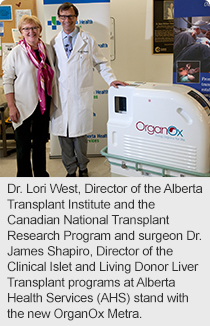
April 6, 2015
Story by Sharman Hnatiuk; photo by Stephen Wreakes
Wilfred Siu has made transplant history.
This year, the 70-year-old city resident became the first patient in North America to receive a donor liver that had been connected to a portable ex-vivo perfusion device prior to transplant.
Surgeons at the University of Alberta Hospital (UAH) are the first transplant team in North America to use a leading-edge technology that extends the viability of donor livers prior to transplantation.
The device, called the OrganOx Metra, can keep a donor organ warm outside of the body and viable for transplant up to 24 hours prior to surgery.
 Siu says he’s grateful this equipment and expertise exists here in Alberta. First diagnosed with liver cancer in 2010, he received multiple treatments and surgeries prior to being listed for transplant more than a year ago.
Siu says he’s grateful this equipment and expertise exists here in Alberta. First diagnosed with liver cancer in 2010, he received multiple treatments and surgeries prior to being listed for transplant more than a year ago.
“I was surprised when I finally got the call that an organ was available for me,” says Siu. “I wasn’t sure what to expect, but I am happy that this technology is in Edmonton and it was available for my transplant.”
Traditionally, livers are kept in an icebox for up to eight to 10 hours to allow for transportation and for the recipient to be prepared for surgery.
“Donor organs degrade and become less viable for transplant the longer they are on ice as they need oxygen and nutrients,” says UAH liver transplant surgeon Dr. James Shapiro, Director of the Clinical Islet and Living Donor Liver Transplant programs at Alberta Health Services (AHS) and Professor of Surgery at the University of Alberta.
“Now, once the organ is removed from the donor, tubes are connected to the main blood vessels and the liver is maintained as if it is still in the body, supplied with oxygen, nutrients and kept at body temperature. The liver continues to function and produce bile,” he adds.
“Transplanting a fresh, warm liver means we should expect better outcomes for patients, and the opportunity to repair donor livers outside of the body before transplant could provide our program more viable donor organs for people needing them. I am particularly excited about this technology which could save lives by enabling us to perform more transplants more safely.”
Last year, 77 liver transplants were performed at the UAH. There are currently 126 patients awaiting a liver transplant with the UAH program; approximately one in three patients will die before a suitable organ becomes available.
Alberta’s warm-liver transplant program has been established through a partnership between AHS and the University of Alberta’s Faculty of Medicine & Dentistry’s Alberta Transplant Institute.
The Alberta Transplant Institute contributed $150,000 to help launch the warm-liver transplant program at the UAH.
“The Alberta Transplant Institute, together with the Canadian National Transplant Research Program, is thrilled to support use of this transformative emerging technology for transplantation,” says Dr. Lori West, Director of the Alberta Transplant Institute and the Canadian National Transplant Research Program.
“Only through investment in research initiatives such as this will advances continue to be made in transplant therapies. This will have immediate impact on the outlook for the hundreds of Albertans, and thousands of Canadians, awaiting donor organs, for whom transplantation provides a second chance for a healthy life. Additionally, for families whose loved ones have donated organs, this is a dramatic step forward in ensuring that every donated organ can be transplanted successfully, making the very most of their gift of life.”